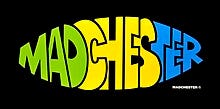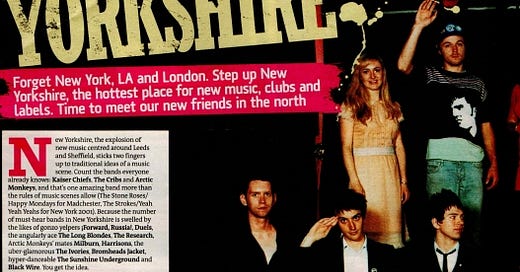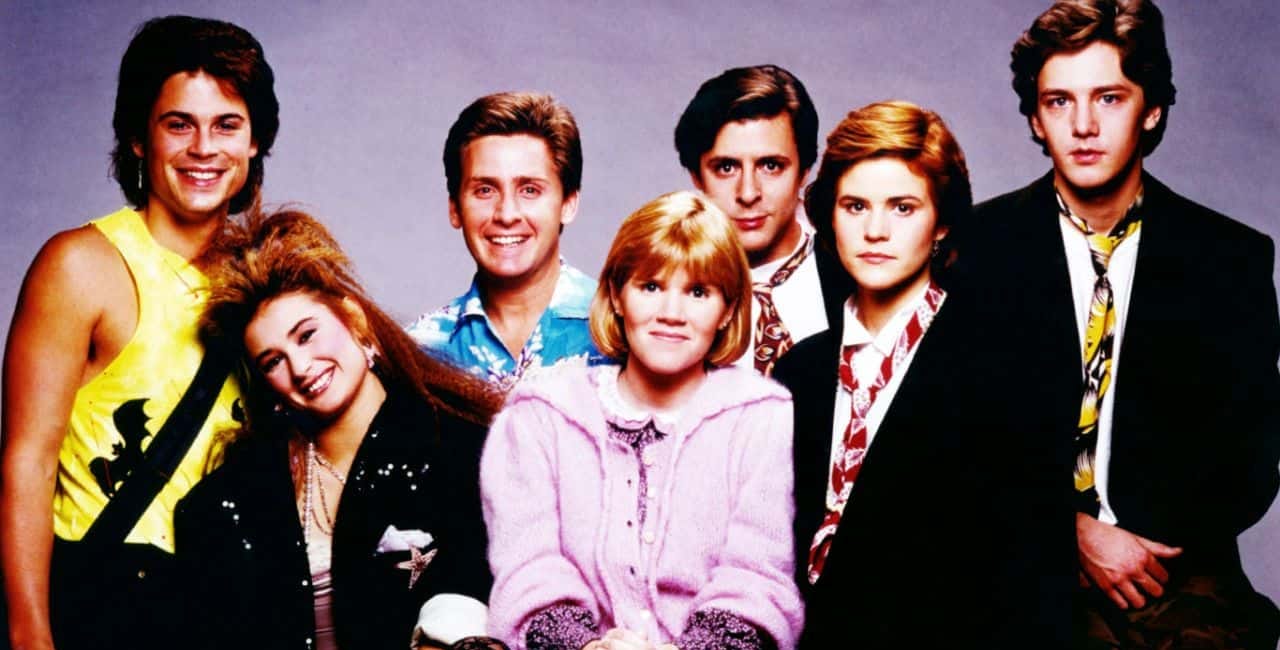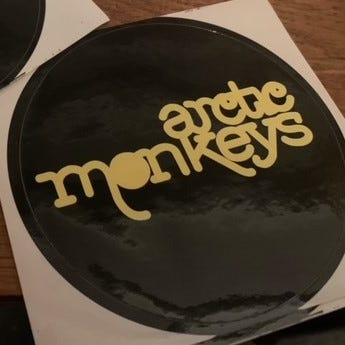Being Caught Up In The Label Of The 'New Yorkshire Wave'
Last week, I looked at how labels were attributed to sets of actors and bands. In this piece, I'll look at how the label of the New Yorkshire Wave affected the bands that were caught up in it.
Regional music scenes have a history of labels being attributed to them. If anything, it helps the media to draw attention to them. One of the most well-known regional music scenes is Merseybeat from 1960s Liverpool, which bore The Beatles as well as Gerry and the Pacemakers. Then there’s Madchester in late-1980s Manchester, which was known for the indie dance scene, the Hacienda nightclub, and proliferation of ecstasy pills.

In the mid-2000s, New Yorkshire was born. The term originally referred to a package tour in 2004 featuring The Cribs, The Blueskins, and 10,000 Things who were from West Yorkshire (Wakefield, Gawthorpe, and Leeds respectively). By the summer of 2005, the term was reborn as the New Yorkshire Wave. Bands from the cities of Sheffield and Leeds were selected for inclusion due to their burgeoning success. Essentially, they became impossible to ignore.
The official announcement for the New Yorkshire Wave came with a feature in the biggest music magazine of the time. In August 2005, NME Magazine was struggling with their circulation numbers and needed to come up with something new, seemingly every couple of weeks. Their Sheffield correspondent, Rick Martin, came up with the term ‘New Yorkshire’ and the New Yorkshire Wave was born.
The Gangs of New Yorkshire photoshoot
In the Gangs of New Yorkshire photoshoot for NME Magazine in August 2005, Black Wire, The Research, The Sunshine Underground, The Ivories, and ¡Forward, Russia! were chosen to represent Leeds’ music scene. On the next page, Bromheads Jacket, Milburn, Harrisons, and The Long Blondes represented Sheffield. In the photos, the bands look chummy, though Black Wire’s bassist, Tom Greatorex, likened it to a ‘sixth-form leavers do’. There was also some confusion over the title of the photoshoot. Was it a reference to the 2002 film, Gangs of New York, or did it imply that each band was a gang in itself?
What is not mentioned in the feature is how the lead singer of Harrisons, Jubby Taylor, chimed that The Long Blondes were ‘not even fucking from Sheffield, what are you doing here?’. While the Brat Pack from the 1980s could imply that named members had established bonds with each other due to socialising in bars as a group, you could not make the same assumption with bands, even if they were from the same city.
Indeed, The Long Blondes’ membership of the New Yorkshire Wave was that they were deemed a ‘Sheffield band’. Yes, they met and rehearsed in the city, yet they toured outside of Sheffield extensively. According to their lead singer, Kate Jackson, there was a belief that her band stood out and that they were both part of the Leeds scene and the Angular Records scene in London. Of course, such individual niches were ignored, it’s simply so much easier to brush them aside.
‘Good press at the time’
Being members of the New Yorkshire scene, and the label itself, was openly called into question. Specifically, by two of Sheffield’s most successful bands. Kate Jackson said that The Long Blondes belonging to the scene ‘didn’t matter once the NME got involved’. Even Matt Helders begrudgingly accepted that Arctic Monkeys were part of the scene, whether they ‘liked it or not’. Crucially, according to Jackson, ‘those were just the bands that Conor [McNicholas] thought would give good press at the time’.
Similarly to the Brat Pack, the bands were already tasting success, so the magazine could be seen as setting the agenda, even riding on their coattails. During the interviews I conducted, it became quite clear that the bands in the photoshoot felt that they were only there due to the staggering success of the region’s leading bands. Kaiser Chiefs and The Cribs had led the way, yet Arctic Monkeys were about to hit number one with their debut single. Though the bands at the photoshoot wanted the publicity, there was a sense of being exploited.
These bands were chosen by the magazine’s editor, McNicholas, to push sales along with the moving trends. You can argue that this followed on from the Brat Pack label helping push sales of New York Magazine, something I looked at last week. Sensationalism and youthful good looks clearly sells.
Labels. How They Help The Media, Not The Artists
Occasionally, artistic movements capture the zeitgeist of a certain time. Seizing the opportunity, journalists grant the key figures in those movements a label. That can be a group of individuals or bands who seem to capture the prevalent energy of the time, something new and exciting.
While creating a label helps the media, it harbours the creative instincts of the individuals involved. Part of the anxiety of a band’s existence is never being allowed to rest on your laurels and always being judged by the success of the next release. To strike while the iron was hot. Being part of a label added even more complexity to this stressful mindset with a facet that was out of each band’s control. The media had more control over the agenda.
The Label’s Durability
Therein lies the problem and something that was highlighted to me by the Bromheads Jacket bassist, Jono West. If they were part of the New Yorkshire Wave, they were wary of the next group of popular bands. That’s also partly why the band decided not to record with Alan Smyth, as the producer had recorded pretty much every other Sheffield band in the New Yorkshire Wave.
Being labelled as part of the New Yorkshire Wave came with a certain durability, that you would be trendy for only as long as the label stuck, before the media moved onto something else. In this case, it was ‘new rave’ and bands like Klaxons, CSS, and New Young Pony Club. The Sunshine Underground were also included, which means they could enjoy life in both labels.
In grouping them together, and giving them a label, attention was aimed towards the indie trailblazers. You could suggest that Arctic Monkeys, Milburn, Harrisons, and Bromheads Jacket sounded like they could be found in the same genre, yet each band knew each other. You could not make the same suggestion with The Long Blondes. Even more so in Leeds with the ‘dance rock’ of The Sunshine Underground and the ‘math-rock’ of ¡Forward, Russia! Again, those niches were somewhat brushed aside, it was easier to celebrate an eclectic set of bands from the same area, rather than do a deep dive into what made each one stand out.
‘THE most cringe feature I have ever had the displeasure to be involved with’
Not every band wanted to be in the Gangs of New Yorkshire photoshoot. The above quote is from the Harrisons bassist, Ashley Birch, in an article entitled; 'The death of NME: A Sheffield obituary’. The cringeworthiness of the feature came from how the label was exploitative and a means for the magazine to sell copies by coming up with the latest regional music scene. Something exciting was happening in Sheffield and Leeds at the time, but it didn’t need NME Magazine to feature it. Interviewees were worried that the national media would look to it as a fad and milk it for all it was worth. They were right to be.
If you were to delve into the past of the national media, you would see that it was their modus operandi. Before the New Yorkshire Wave there was Madchester, the New Wave of the New Wave, and Britpop. It was treated as a phenomenon when, to seasoned members of the city’s music scenes, it happened year in, year out.
The Double-Edged Spotlight
A large part of the appeal of the New Yorkshire Wave was indeed down to the success of the region’s leading bands. In being part of the Gangs of New Yorkshire photoshoot and being labelled as the New Yorkshire Wave, these bands were attaching themselves to a trend.
The double-edged spotlight was crucial. While Arctic Monkeys, Kaiser Chiefs, and The Cribs, led the way, other bands in the label could enjoy the spotlight that their success brought. With it came a caveat, that success also lifted the bar and expectations rose with it. Bands were signed from both Sheffield and Leeds that likely would have struggled otherwise, a point made to me by Little Man Tate’s lead singer, Jon Windle. Black Wire were already signed but at the time were not thinking years ahead, they needed to promote their album and take full advantage of the spotlight as it shone.
Contrast that with members of the Brat Pack. Not every single actor enjoyed the same hedonistic lifestyle, yet several had their careers dogged by drug and alcohol abuse. The overall belief was that many could have had different careers marked by more serious roles, had it not been for that label and the article itself. Thankfully, the films have lasted, and the actors look to have led respectable lives outside of the spotlight.
Arctic Monkeys, Kaiser Chiefs, and The Cribs still tour to this day, while Bromheads Jacket and Milburn have reformed, which is testament to their durability. However, other bands such as The Ivories, The Research, and Black Wire had all split up within a couple of years of the photoshoot. With hindsight, being a band in the New Yorkshire Wave was beneficial, only for as long as the spotlight was on the region.






